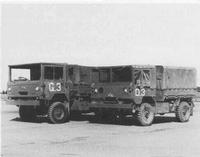


Chapter 13
I Colonial Origins
II First World War
III Between The World Wars
IV The Second World War
V Post-second World War
VI After The Joint Project
VII Science And Decisions At The Top
VIII Armed Services Technology
i Army Design
ii Navy Design
iii Air Force Investigations
iv Food Science
IX New Tasks And Projects
X Transfer Of Research And Development
XI Acknowledgement
References
Index
Search
Help
Contact us

Army Design
Precise specification of items to be produced was usually achieved within the Army Design Establishment,[68] later the Engineering Development Establishment (EDE), by the development of experimental models, often to a prototype stage. The participation of industry was always kept in mind. Often, with the larger and more complex equipment, specifications were undertaken in collaboration with likely industrial contractors. This was particularly evident when a heavy vehicle design industry existed in Australia. (This is no longer the case.) Cross country general service vehicles, both four and six wheeled two and a half and five tonne carrying capacity were developed and finally produced by International Harvester Co. as was also an excellent one tonne four wheel drive vehicle to prototype stage, both by that company and by Ford Motor Co. (working with EDE). That this vehicle did not enter production was a surprise to many Army personnel; it was able to demonstrate superior performance to other units of overseas manufacture offered for consideration at a later date.
As vehicle design capability dwindled within industry, the Army concentrated its attention on detailed specification and extensive field testing of new equipment as the requirement arose. Its Trials and Proving ground at Monegeetta, Victoria, and facilities of the Joint Tropical Trials and Testing Unit near Innisfail in Queensland were essential aids for complete evaluation of offerings. The ability of vehicle frames and components to withstand the rigours of a long life in the field was rapidly evaluated using test rigs applying a known spectrum of loadings in the same fashion as aeronautical engineers subjected aircraft structures to fatigue tests.
These procedures applied to the evaluation of 8 tonne and 4 tonne vehicles supplied from overseas and to a lesser extent to the German Leopard and American MGO Tanks. It was still possible for Government ammunition factories to collaborate with the Army Design Establishment in equipment modification, for example the American M113A1 armoured personnel carrier fitted with a Saladin Turret operated by the Cavalry units in artillery support was converted to a fire support vehicle, by replacing the Saladin Turret with the 76 mm gun and turret for the British Scorpion light tank.

Organisations in Australian Science at Work - Army Design Establishment; Australia. Department of Defence; Engineering Development Establishment; Ford Motor Company of Australia; International Harvester Company; Joint Tropical Trials Research Unit (J.T.R.U.)
 |
Australian Academy of Technological Sciences and Engineering |  |
© 1988 Print Edition pages 961 - 962, Online Edition 2000
Published by Australian Science and Technology Heritage Centre, using the Web Academic Resource Publisher
http://www.austehc.unimelb.edu.au/tia/945.html